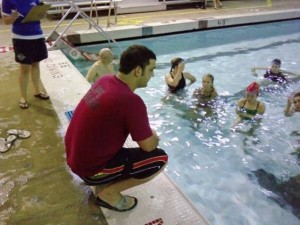Drowning typically occurs among young children and those who do not know how to swim, but even experienced swimmers end up susceptible depending on the water currents, weather conditions, overall health and other circumstances.
Remember that drowning is one of the leading causes of death among children between 1-4 years old. It will only take a few seconds for a child to drown. Small children can drown in just a few inches of water such as in a bathtub, bucket or toilet.
Safety precautions
Parents and caregivers must closely watch children if they are close to any water sources, particularly pools, lakes or the beach. Parents should also be aware of the limits of their child’s ability to swim and set rules when playing around water. Do not leave children unsupervised and be prepared with a first aid kit on hand since you never know when you might need one. The following are safety precautions to bear in mind:

- Children should be taught to swim
- Do not swim alone
- Do not dive into unfamiliar water
- It is recommended to swim in places that are supervised and children should not be allowed to swim without adult supervision
- Safety fences must be installed with fasteners around swimming pools
Safety precautions while at the beach
- It is recommended to swim close to a lifeguard tower and do not swim alone
- Always use sunscreen with at least an SPF 15 for protection
- Ask the lifeguard regarding the beach conditions before going in the water and obey warning signs in dangerous areas
- Do not overestimate your swimming ability and do not depend on flotation devices for safety
- Avoid drinking alcoholic beverages while swimming
- Do not run and dive in the water
Take note that boating accidents can also lead to drowning. Many cases involving fatalities while boating were not using any kind of flotation device. Understandably, just because you know how to swim does not mean that you no longer need to wear a life jacket anymore. Remember that wearing a life jacket is vital for anyone who goes out to the water.
What to do when an individual is drowning
If an individual is drowning, you have to check the area and alert a lifeguard if one is nearby. Call for emergency assistance right away.
- Do not attempt to rescue a drowning individual while in the water unless you are trained to do so and have life-saving equipment. Remember that individuals who are drowning are panicking and will pull you underwater. Rip tides and strong currents can also put you in danger.
- If possible, try to reach out or throw an object that floats to the individual from a secure area such as boat, dock or swimming pool ladder.
- When pulling an individual from the water, tilt the head backwards and raise the chin. Assess for breathing and other indications of life. Try to expel fluid or other objects from the mouth. If breathing is absent, deliver 2 steady rescue breaths. If the rescue breaths are successful, perform CPR. If not, try to shift the airway and try again.
